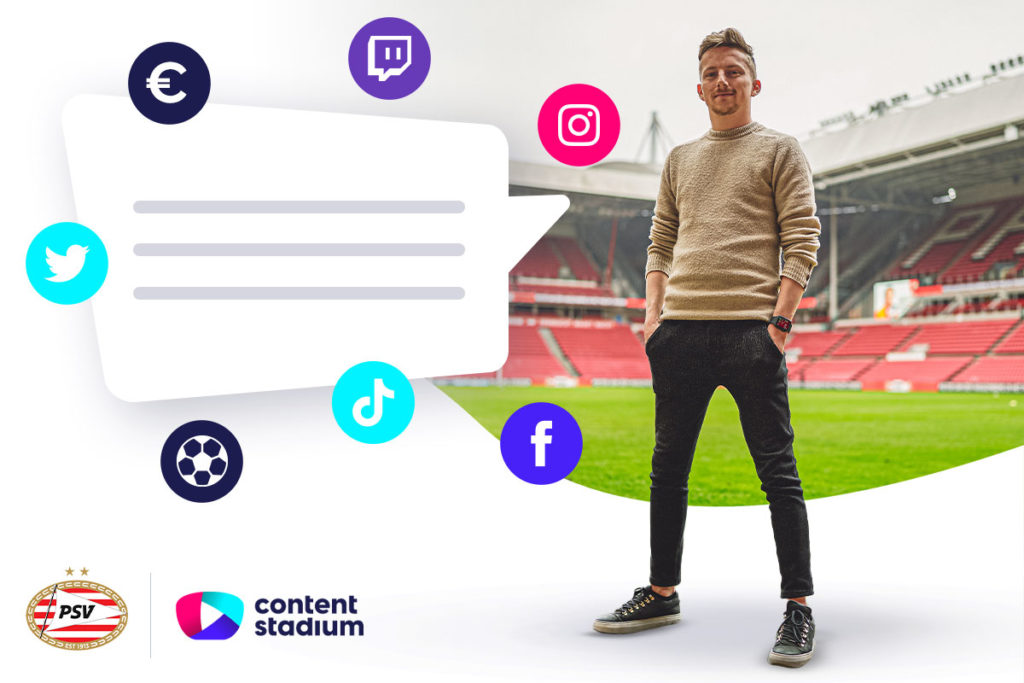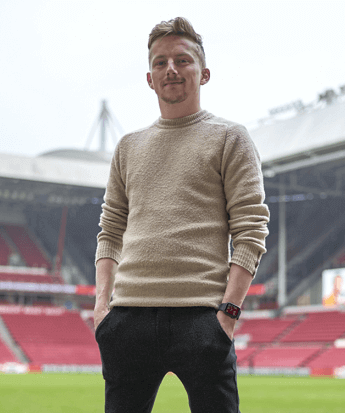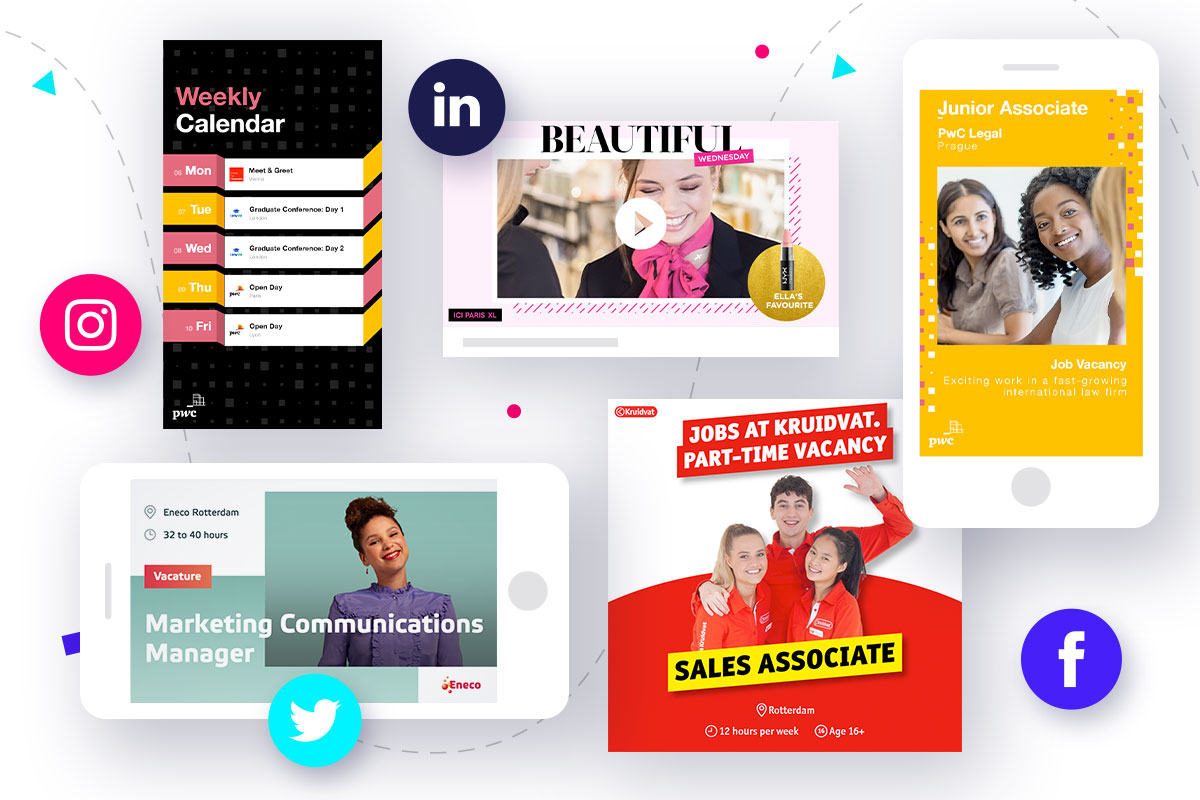Jordy Koppen is the Acting Head of Content & Media at Dutch football club PSV Eindhoven, and a Content Stadium client. He started at the club in 2015 as a Social Media Editor, which was the first role of its kind, dedicated entirely to social media, for a Dutch football club.
After managing and growing the club’s social media channels over six seasons, Jordy moved to a Content Creative role. In this role, he is involved in all creative concepts and content made for PSV’s channels, with a goal to improve creatives and ensure they are aligned with the club’s brand, strategies, and objectives. Nowadays, Jordy is responsible for the whole Content & Media team as the department head.
Based on his more than 7 years of hands-on experience in football social media, as well as his ongoing Masters in Football Business, we asked Jordy to share his learnings and best practices for sports social media.
Q. What is your top piece of advice for the social media teams of other football clubs and sports organizations?
Jordy Koppen: My biggest tip is to put in place (and stick to) a social media strategy that supports your wider club or business goals. At the end of the day, that’s why we have social media channels: to help reach these higher-level goals. In my case, I work closely with our marketing, business, and merchandising departments to ensure our content aligns with their objectives.
However, I see that many football clubs’ social media teams focus on trying to go viral, or making “fun” content, without having a real strategy in place. And while it’s fun to reach and engage large audiences, you should always ask yourself: why are we doing this? And how does the club benefit?
In the end, for most football clubs, the bottom line is monetization and revenue. Marketing and media activities should always lead to revenue, directly or indirectly. So a post that reaches 1 million people might seem great, but realistically 95% of those people will likely never spend a penny, or euro, or dollar on our club.
So that would be my top advice: don’t forget why you do what you do, and always keep your goals in mind.


While it’s fun to reach and engage large audiences, you should always ask yourself: why are we doing this? And how does the club benefit?
Q. Talking of goals, what are your main social media goals at PSV?
Jordy: Our Content & Media team focuses on three main goals: fan engagement, fan acquisition, and monetization. We aim to push fans through a multistep funnel, with profile building, personalization, and revenue as the ultimate goal:
- Be, or become a supporter.
- Follow us on any social media platform or join us via our website or app.
- Join our database (because, if the social media channels are gone tomorrow, our follower base is gone as well), through taking part in giveaways and other activities.
- Opt-in to emails.
- Buy from us.
- Stay loyal (many companies try to turn their customers into fans; football clubs try to turn their fans into customers).
Our job is step 1 and 2. We want to engage our current followers by creating and offering relevant content (fan engagement). When we’re doing a good job there, new football fans, or PSV fans, will start to find and follow us (fan acquisition). Our Marketing Intelligence team takes care of the rest of the funnel, by trying to get all followers into our database.
Q. What are the biggest social media trends you’ve noticed during your time in the industry?
Jordy: The biggest shift on social media over the past few years (inside and outside the sports world) is that organic content has become mass media, heavily focused on entertainment.
In the past, your posts would reach your follower base, and football clubs mainly used social media to inform people about what’s going on at the club. But platforms have now switched their algorithms so that it’s more about entertainment, presenting yourself as a cool brand, and trying to go viral, as your content can reach anyone in the world, whether they follow you or not.
Nowadays, you have zero guarantees that your organic content reaches the people you want to reach (local, spending fanbase for example). You have no control over who you reach. It’s basically a lottery.
The world’s biggest football clubs can benefit from this change because they have fans worldwide. But this trend makes it harder for the majority of clubs to meet their goals, such as informing followers, collecting data or driving people to our fan store through organic social media content. To reach these goals, we’re now focusing on paid advertising and segmenting our social media channels.
Q. Do you have a different strategy for each social media channel?
Jordy: The main difference in strategy is that we target and cater to different audiences on each social media platform. We also created multiple accounts on some channels, to further segment our target audience and content goals.
We currently have accounts on Instagram, Facebook, Twitter, TikTok, Snapchat, LinkedIn, YouTube, Twitch, Weibo and Dongqiudi. These include both main accounts, and subaccounts, such as PSV Women, PSV FANstore, and PSV Esports on Facebook and Instagram, PSV Español on Twitter, and even an account for our mascot on TikTok, YouTube Kids and Instagram.
@phoxy99 Terug in de tijd… 🦊 #Phoxy #PSV #meearlier ♬ origineel geluid – PSV Esports
A few years ago, we used to post all types of content on our main channels, including academy, women, foundation content, etc. But 80-90% of our followers follow us for our first team. That’s why we created multiple channels. Having these separate channels helps us to offer our audiences a more tailored, personalized experience on social media (similarly to how you might segment your audience with paid media or email marketing).
At the same time, this segmentation allows us to build new fanbases. Take PSV Women, for example. These accounts have a completely different audience, including families and women, who only want to follow PSV Women. They can become a fan of PSV, without necessarily liking or following the first team. It’s another growth market.
The different social media platforms also play a role in our targeting and the type of content we post. For example, on TikTok we target younger audiences with meme content, trending sounds, and generally more “fun” content. While on Facebook, where the average user age is higher, we post more “serious” content, such as more standard game highlights with a more serious tone. It’s more focused on infotainment instead of pure entertainment. However, it’s just a matter of time before Facebook turns into a pure entertainment channel as well.
Q. What kind of content do you think works best on social media?
Jordy: Following TikTok’s lead, which cracked the formula on how to keep people in the app with endless “dopamine shots”, all social media platforms are giving priority to (short-form) videos. This includes Instagram Reels, YouTube Shorts, and even Facebook, which now serves up recommended videos from accounts people were not even looking for.
The best-performing social media content also depends on the platform. As I mentioned before, TikTok offers almost a free pass to do whatever you want, while on Facebook, where the audience is generally older, we need to be a little more serious.
However, “what content works best” ultimately depends on your strategy and KPIs. For example, if your goal is to increase website visits, you should focus on how much traffic a post drove to your website, and not obsess over the number of video views or likes. In short, “best” has a different meaning to everyone. Some have (brand) awareness goals, some traffic, some monetization.
Q. How do you ensure that your content stays on-brand?
Jordy: At PSV, we focus on both “visible” and “invisible” brand guides and elements.
The “visible” brand includes all visual cues, such as our logo, motto, shirts, fonts, etc. We ensure we are consistent with these visual brand elements in everything we create. This is where Content Stadium comes in. They have been building custom branded templates for us for a few years now, which members of the media team can use to create visuals. This works very well for us, as it ensures our content is always visually on-brand, and no one does his or her own thing.
We also have a brand design team who create additional visuals. We choose to keep all our content creation in-house so we can have control over it.
The other, “invisible” part of staying on-brand is about having a consistent brand story and values. Our brand values are energy, unity, no-nonsense, unconventional, and international. Whenever we create something new — a new concept, a new video, etc. — we think, how does this fit into our story? We want our brand values to come through the content we make, and we want our fans to be able to recognize these values.
Q. Are there any other clubs that you think do a great job on social media?
Jordy: The football club we’re learning from the most is RSC Anderlecht in Belgium. Their branding is well-defined and recognizable, and they tell a strong story throughout their content, from their videos to their captions and photos. Everything is consistent. I also like the emotions that come through their content, as well as the connection they have with their city, and how they use local influencers, rappers, musicians, and fashion icons in their content. Great storytelling sets you apart from the rest. It’s key.
Sporting op Leuven. 🟣⚪ #OHLAND pic.twitter.com/br0kUSinvk
— RSC Anderlecht (@rscanderlecht) March 19, 2023
Chelsea FC also does a great job at storytelling, while Manchester United FC has really good designs. What all three of these clubs do really well, is that they are consistent in maintaining their brand elements — you can instantly tell that it’s them — but at the same time, they always vary their designs and come up with new creatives.
More social media tips for sports
Are you looking for more best practices and inspiration for your football club or sports organization? You might also be interested in these articles:
- Discover 15 football social media ideas and post examples to level up your strategy.
- Read our interview with Troy Lüchinger, CMO at Swiss football club FC St.Gallen 1879 on his social media learnings and recommendations.
- Get tips on how to monetize your sports social media content.
- Find out more about our content creation platform for sports (social) media teams:




